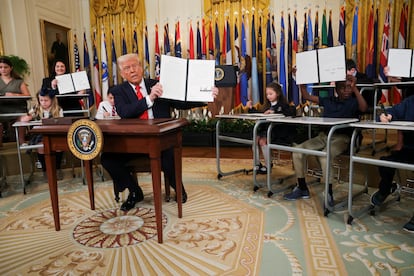Trump administration introduces new changes to student loans
Republicans in Congress, backed by the president, have put forward a sweeping credit reform plan

After a five-year break that began during the covid pandemic, federal student loan collections officially resumed on May 5. For millions of Americans, this marks not only the return of financial obligations, but the beginning of a significant transformation in the way student loans are administered, repaid and forgiven under the Trump Administration.
Student loan payments were first suspended in March 2020 as part of pandemic relief efforts under the CARES Act. The Biden administration extended the pause several times, while introducing new forgiveness programs and more flexible repayment options. But with Trump back in office, many of those policies have been reversed.
As of May 5, borrowers in default — those who haven’t made a payment in more than 270 days — are once again subject to aggressive collection tactics. The Department of Education, through a Treasury Department program, can now garnish wages, seize tax refunds and reduce Social Security and disability benefits. According to the credit bureau TransUnion, more than 20% of loans were more than 90 days past due in February 2025, nearly double the pre-pandemic rate.
Who is affected?
Approximately 43 million Americans have federal student loans, and the total outstanding balance is estimated at $1.693 trillion. The average borrower owes about $38.375. While many had hoped for continued relief or forgiveness, the Trump administration has taken an entirely different approach.
“American taxpayers will no longer be forced to serve as collateral for irresponsible student loan policies,” said Education Secretary Linda McMahon, referring to Biden-era initiatives. The Administration has accused the previous administration of misleading borrowers about the federal government’s legal authority to cancel debt.

Changes to student loans
The most drastic change is not just to collection enforcement, but to the entire structure of the federal student loan system. Republicans in Congress, backed by Trump, have put forward a reform plan called the Student Success and Taxpayer Savings Plan, which would take effect July 1, 2026.
The plan would reduce the current dozen payment options to just two: a standard flat refund plan and a new income-based plan called the Refund Assistance Plan (RAP). Under the RAP, borrowers’ monthly payments would range from 1% to 10% of their income. While the plan offers a $50 per child discount to parents and forgives interest on some payments, it would extend the loan forgiveness term to 30 years and eliminate current protections that exempt a portion of income from the repayment calculation.
In addition, unlike the Biden-era SAVE plan and previous IDR programs, the new GOP model would not offer early forgiveness and explicitly eliminates provisions that allowed certain defense workers and nonprofit employees to qualify for Public Service Loan Forgiveness (PSLF).
The Department of Education
Separately, Trump has signed an executive order directing the dissolution of the Department of Education. Although total elimination would require an act of Congress, for the time being, large portions of its appropriations are being moved. Student loan management will move to the Small Business Administration (SBA), while special education and nutrition programs will go to the Department of Health and Human Services (HHS). This comes despite a 40% staff cut at the SBA, raising questions about its ability to handle the large budget.

The restructuring has drawn sharp criticism from education experts and advocates for the disabled, particularly in response to the assignment of roles within HHS to controversial figures such as Robert Kennedy Jr.
Borrowers have also expressed concern about the growing dysfunction within the system. Earlier this year, the Department of Education eliminated online applications for popular repayment plans, including income-driven repayment (IDR) and federal loan consolidation. Although these services were eventually restored, the disruption left millions of people in limbo.
Similarly, hundreds of Federal Student Aid (FSA) employees were laid off, further delaying communication with borrowers and the processing of forms.
Programs reduced, not eliminated
Despite the cuts and policy changes, some avenues for debt forgiveness remain. PSLF remains in effect, but now excludes employees of nonprofit organizations involved in “activist” or “improper” activities, according to a recent executive order. Teacher loan forgiveness remains available to eligible low-income school educators, offering up to $17,500 in debt relief.
The Biden-era SAVE plan, which caps monthly payments based on income and forgives balances after 10 to 20 years for some borrowers, is still technically active. However, its future is uncertain given Trump’s opposition to broad debt relief.
Programs such as the total and permanent disability discharge (TPD), which offers forgiveness for borrowers with certified disabilities, have also so far been unaffected.
Tu suscripción se está usando en otro dispositivo
¿Quieres añadir otro usuario a tu suscripción?
Si continúas leyendo en este dispositivo, no se podrá leer en el otro.
FlechaTu suscripción se está usando en otro dispositivo y solo puedes acceder a EL PAÍS desde un dispositivo a la vez.
Si quieres compartir tu cuenta, cambia tu suscripción a la modalidad Premium, así podrás añadir otro usuario. Cada uno accederá con su propia cuenta de email, lo que os permitirá personalizar vuestra experiencia en EL PAÍS.
¿Tienes una suscripción de empresa? Accede aquí para contratar más cuentas.
En el caso de no saber quién está usando tu cuenta, te recomendamos cambiar tu contraseña aquí.
Si decides continuar compartiendo tu cuenta, este mensaje se mostrará en tu dispositivo y en el de la otra persona que está usando tu cuenta de forma indefinida, afectando a tu experiencia de lectura. Puedes consultar aquí los términos y condiciones de la suscripción digital.











































